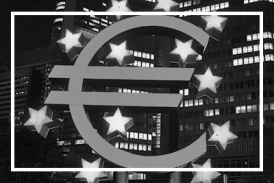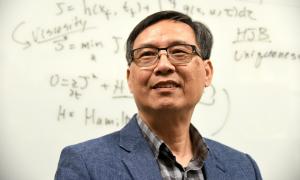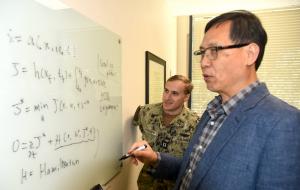Navy Applied Math Professor Wei Kang Named 2025 SIAM Fellow
Wei Kang, a Naval Postgraduate School professor in the Department of Applied Mathematics, was honored by the Society for Industrial and Applied Mathematics.
MONTEREY, CA, UNITED STATES, April 18, 2025 /EINPresswire.com/ -- Recognized for outstanding research and service to the community, Wei Kang, a Naval Postgraduate School (NPS) professor in the Department of Applied Mathematics, was honored by the Society for Industrial and Applied Mathematics (SIAM) as a 2025 SIAM Fellow. Applied mathematics provides a foundation for all kinds of leading-edge research into complex science and technology with naval and defense applications.
A leading professional society for math whizzes, SIAM selected 25 Fellows from its international community of 14,000 members who represent almost 500 organizations worldwide, including academia, manufacturing, research and development, service and consulting, government, and military. In July, the Fellows will be celebrated during SIAM’s annual meeting in Montreal, Canada.
SIAM selected Kang for his “fundamental theoretical and computational contributions to the analysis, control, and estimation of nonlinear dynamical systems and their applications.” With a smile, Kang was quick to simplify this into dynamic systems and controls, a field he says where applied mathematics and engineering overlap.
“There are many things in nature that if you know the current state, then the first principles of physics will tell you what's going to happen next,” Kang said. “A dynamic system is a mathematical concept where if you have a numerical model and give it the current state, it can predict the future. But telling the future is still hard.”
Better understanding of dynamic systems allows them to be better predicted and controlled, Kang added.
“I've been working on control systems. Think about an uncrewed vehicle, for example. It has a feedback control system to allow it to do things autonomously,” he explained. “But there are many different kinds of control systems. These days, I’m also integrating machine learning, data science and AI techniques into dynamic system applications.”
At NPS, Kang and his students collaborated on multiple projects, including data simulation for numerical weather prediction with the U.S. Naval Research Laboratory, data assimilation for combustion dynamics of rocket and jet engines with the Air Force Research Laboratory, and power system anomaly detection with the Office of Naval Research’s Next Strategic Technology Evaluation Program, known as NextSTEP.
Kang is also part of a multi-institutional collaboration with the National Science Foundation that is investigating the mathematical foundations of machine learning.
Recognizing his interdisciplinary area of expertise, Kang is also a Fellow with the Institute of Electrical and Electronics Engineers (IEEE), the largest science, engineering and technical professional organization in the world, and an adjunct professor at the University of California at Santa Cruz. For more detail on Kang’s background and to explore his teaching and research interests, visit his website.
At professional societies like SIAM, Fellows are not only recognized for their knowledge of the discipline and innovative research. Kang values his service to the discipline as an invaluable investment in the future, acting as chair of two international systems and controls conferences and as vice chair of the systems and controls activity group.
Dr. Ralucca Gera, professor and chair of the NPS Department of Applied Mathematics, acknowledged the importance of Kang’s prestigious accomplishment.
“This recognition not only highlights Professor Kang's exceptional contributions to the field of applied mathematics but also underscores the impact of his work on advancing mathematical research,” she said. “As a SIAM Fellow, Professor Kang joins an elite group of mathematicians whose work drives innovation and excellence, further solidifying the Naval Postgraduate School's reputation as a leader in higher education and research within the Navy and DOD.”
LCDR Kristina Wiedemann, USN
Naval Postgraduate School
+1 831) 656-3567
email us here
Visit us on social media:
Facebook
X
LinkedIn
Instagram
YouTube
Legal Disclaimer:
EIN Presswire provides this news content "as is" without warranty of any kind. We do not accept any responsibility or liability for the accuracy, content, images, videos, licenses, completeness, legality, or reliability of the information contained in this article. If you have any complaints or copyright issues related to this article, kindly contact the author above.
Body Mist Market Expected to Hitting $14.0 Billion by 2035, Annually Expand at 5.0% CAGR
Grain Mill Products Market Size Worth USD 830.8 Billion by 2026 With CAGR of 3.4%
كيوليس ام اتش اي تحتفي بـ"عهد الاتحاد" وتؤكد التزامها بدورها التنموي وترسيخ قيم الولاء
Kalendarium
Więcej ważnych informacji
 Jedynka Newserii
Jedynka Newserii

 Jedynka Newserii
Jedynka Newserii

Prawo

KE proponuje nowy Fundusz Konkurencyjności. Ma pobudzić inwestycje w strategiczne dla Europy technologie
W środę 16 lipca Komisja Europejska przedstawiła projekt budżetu na lata 2028–2034. Jedna z propozycji zakłada utworzenie Europejskiego Funduszu Konkurencyjności o wartości ponad 400 mld euro, który ma pobudzić inwestycje w technologie strategiczne dla jednolitego rynku. Wśród wspieranych obszarów znalazła się obronność i przestrzeń kosmiczna. Na ten cel ma trafić ponad 130 mld euro, pięciokrotnie więcej niż do tej pory.
Firma
Były prezes PGE: OZE potrzebuje wsparcia magazynów energii. To temat traktowany po macoszemu

Choć udział odnawialnych źródeł energii w miksie energetycznym Polski jest stosunkowo wysoki i rośnie, to ten przyrost jest chaotyczny i nierównomiernie rozłożony miedzy technologiami – wskazuje Forum Energii. Dodatkowo OZE potrzebują wsparcia magazynów energii, a zdaniem Wojciecha Dąbrowskiego, prezesa Fundacji SET, ten temat jest traktowany po macoszemu. Brak magazynów powoduje, że produkcja energii z OZE jest tymczasowo wyłączana, co oznacza marnowanie potencjału tych źródeł.
Infrastruktura
Wzrost wynagrodzeń ekip budowlanych najmocniej wpływa na koszty budowy domu. Zainteresowanie inwestorów mimo to nieznacznie wzrasta

Budowa metra kwadratowego domu w Polsce kosztuje od 5,55 do 6 tys. zł w zależności od województwa – wynika z najnowszych analiz firmy Sekocenbud. Najdrożej jest w Warszawie, gdzie cena za metr kwadratowy domu przekroczyła już 6,2 tys. zł. Na przyrosty kosztów budowy domu wpływają zarówno drożejące materiały budowlane, jak i wyższe wynagrodzenia pracowników. Inwestorzy nie rezygnują jednak z budowy domów jednorodzinnych, co ma związek m.in. z wciąż wysokimi cenami mieszkań czy też obniżką stóp procentowych.
Partner serwisu
Szkolenia

Akademia Newserii
Akademia Newserii to projekt, w ramach którego najlepsi polscy dziennikarze biznesowi, giełdowi oraz lifestylowi, a także szkoleniowcy z wieloletnim doświadczeniem dzielą się swoją wiedzą nt. pracy z mediami.










.gif)

 |
| |
| |
|